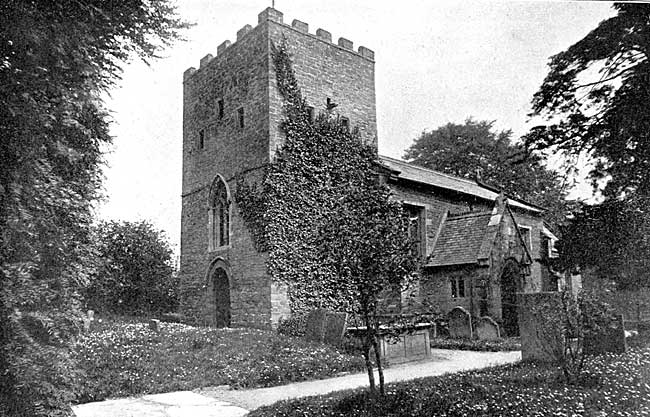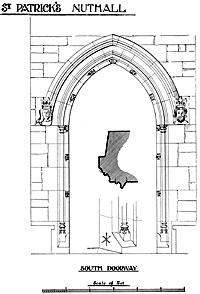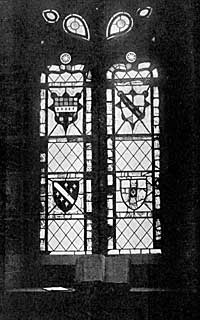Excursion, 1906.
THE Strelley district was selected for the Thoroton Society's excursion in 1906, the itinerary including Nuthall, Strelley, Stapleford, Attenborough, and Beeston. For this excursion, which took place on June 20th, the Society were fortunate in having a perfect summer's day. The party numbered nearly seventy, including Messrs. R. Fitz Hugh, J. T. Spalding, G. Fellows, H. Gill, J. P. Briscoe, H. W. P. Pine, F. W. Dobson, W. R. Hamilton, J. H. Beardsmore, G. E. Hore, J. Thorpe, G. G. Bonser, T. C. Smith-Woolley, James Granger, W. B. Thorpe, Kenneth Hill, C.J. Williams (of the British Archaeological Society), J. Ward, W. Birchall, A. Stapleton; Revs. J. R. Taft, T. W. Windley, G. W. Oxenham, A. Du Boulay Hill, J. Standish, and H. Williams. Four brakes carried the party, a start being made from Station Street, Nottingham, at 9.30 a.m.
The first stop was made at Nuthall, and a visit was made to the village church, where Mr. H. Gill read the following paper.
Nuthall Church
By MR. H. GILL

Nuthall Church.
Pleasantly situated by the wayside, and standing near to one of the ancestral homes of the shire, the little church of St. Patrick at Nuthall, with its ancient yew tree shading the entrance, is a typical picture of an old village church.
The early dedication is still retained, and the church has the distinction of being the only one in the county dedicated to St. Patrick—probably owing to the fact that the original church was built and endowed by a member of the ancient Nottinghamshire family of St. Patrick or Patricius, who were lords of the manor in those days (or the St. Patricks may have taken their name from the church).
Of the “Church at Nutehale,” mentioned in Domesday, not a vestige remains. The oldest part of the present structure is the Tower half of the Early English tower, up to the projecting string-course. Like all towers of that period it is massive, rectangular in plan, without buttresses or “set-offs,” and was probably surmounted by a low wooden spire. The upper portion of the tower was taken down and rebuilt in the middle of the 18th century. The window over the west door was inserted when the church was restored in 1884.

South doorway, Nuthall Church.
On entering the south porch the inner doorway attracts attention by its graceful proportions. It is a good example of its kind (early Perpendicular) and corresponds in every detail with a doorway in the south choir aisle of Southwell Minster. I think it is most probable that the crowned heads forming the stops to the hood-mould were intended to represent King Henry IV. and his Queen, Joan of Navarre. At any rate, to adapt a line from Shakespeare, “their crowns say so,” and the features bear a close resemblance to the effigies on the royal tomb in Canterbury Cathedral. Moreover, it is interesting to notice that on the Southwell doorway, which being internal, is in a splendid state of preservation, the king is decorated with the Collar of S, the well-known badge of the new order of knighthood founded by the first Lancastrian king.
On the reveal, at either side, quite close to the threshold, a mason’s mark in the form of a cross or star has been roughly incised. These may be the consecration marks, although the position is somewhat unusual.
Passing into the church, the contrast between the slender details of the doorway and the sturdy work of the tower arch—each reflecting the character and spirit of its time—is most marked. The shape of the arch (now much distorted by settlement), the circular abacus of the capital, the contour of the mouldings, especially the “pudding roll” of the base, all determine this to be Early English work—circa 1200.
The arcade of three bays, separating the nave from the north aisle, and the square-headed windows with flowing tracery, are very characteristic of the village churches of the district, and indicate that the Perpendicular style was near at hand. One feature of that style is that much of the carving and ornamentation is meaningless and unnecessary. Notice in this connection the grotesque animals carved above the capitals of the nave arcade. Their obvious purpose was to form the stop to a hood mold running over the arches, but in this case they are unnecessary because that molding has been omitted.
The chancel screen is a good example of Perpendicular woodwork. This is not a remnant of the rood-screen of pre-Reformation days. It was originally a parclose screen, enclosing a chapel at the east end of the aisle—probably the ancient chapel of St. Mary—as the will of Dame Margaret Cokefield, made at Wollaton in 1642, directed that she was to be buried “in the Chapel of St. Mary, within the Church of St. Patrick of Nuthall, against Sir John Cokefield, her deceased husband.” When the church was restored in 1884, this screen, then used for enclosing the Temple pew, was taken down and repaired and refixed in its present position, with the cross and iron gates added. When the side chapel was in use a hagioscope, or squint, was necessary to enable the high altar in the chancel to be seen. The removal of the screen has revealed the western face of it, but the eastern face is blocked by the masonry of the north wall of the chancel and organ chamber.

Armorial window, Nuthall Church.
It has been suggested that the ancient armorial glass in the east window, and in the window behind the rector’s prayer desk once adorned one of the religious houses in the neighbourhood, and were brought here for preservation after the Suppression. I am, however, inclined to think that it indicates that this little church, built at a time when painted glass had become general, once displayed a wealth of colour in all its “storied windows richly dight.”
The arms in the east window are :—
(1) Barry of 5, Arg. and AZ.—GREY OF CODNOR
(2) Arg., a lion rampt Sa., crowned or—MORLEY.
(3) Az, Semée of crosses-crosslet, 3 cinquefoils Arg.—D’ARCY.1
The arms in the south window are difficult to allocate, and any information or suggestions concerning them would be welcomed by the Society. They are:—
(1) Chequy or and az. afesse ermine.
(2) Quarterly Arg. and az. on a bend gules 3 martlets or.
(3) Gules, a bend between 6 crosses - crosslet fitchêe. arg.—HOWARD.
(4) Patchwork of fragments.
Under a sepulchral arch in the north wall of the aisle is an alabaster altar tomb. The effigy is represented with a conical bascinet on his head, resting upon a tilting helm with mantling and crest, viz :—out of a ducal coronet a lion’s jamb ppr.; in front of the bascinet over the temples, the letters IHR nasare an abbreviated form IHS NASARENUS. Attached to the bascinet is a camail of mail; a jupon with a horizontal sword belt around it; beneath the jupon appears an apron of mail, and gussets of mail are seen at the armpits and insteps; the feet in sollerets rest against a lion ; the gauntleted hands are in the usual attitude of devotion. The details of the armour all correspond with the date assigned for the building of the nave and aisle, i.e., the time of Richard II., and there can be little doubt, considering also the position of the monument, that it commemorates the builder of this portion of the church: Sir Robert Cokefield, Lord of the Manors and Patron of the Churches of Nuthall and Basford, and Knight of the Shire in 1389 and again in 1392. The arms of Cockfeld, or Cokefield, are azure, a cross counter compony argent and gules.
(1) It is rather curious that the charges should be here blazoned Sex-foil or Narcissus when they are always stated to be Cinquefoils.
